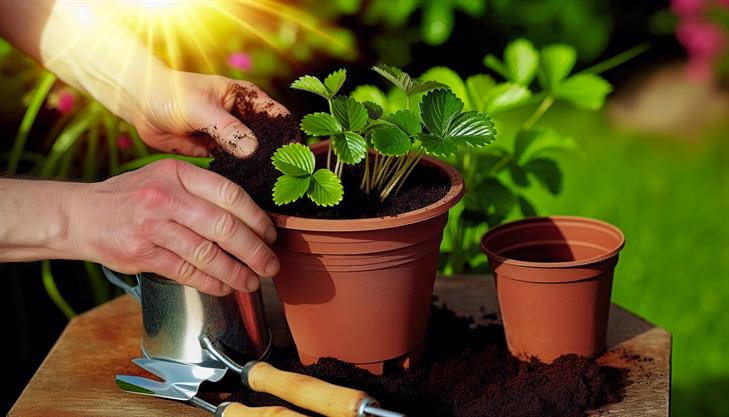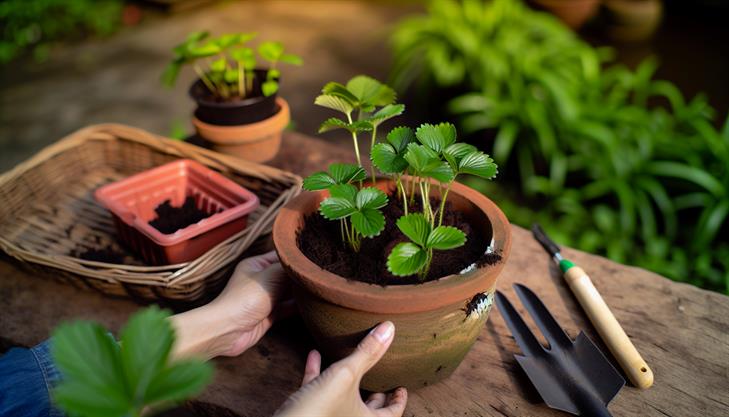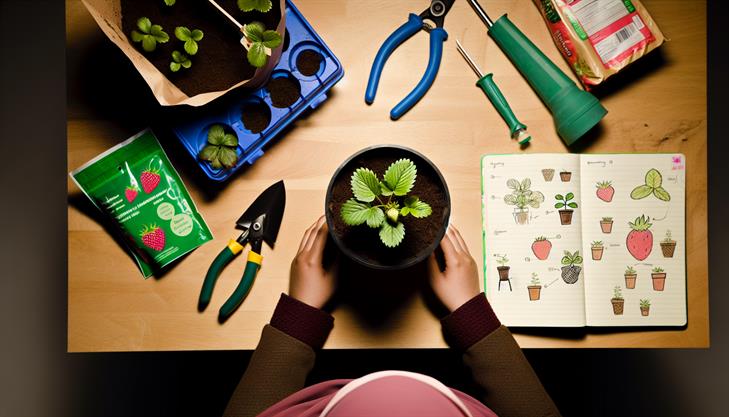Imagine savoring the tangy-sweet burst of a perfectly ripe strawberry, still warm from the sun, plucked fresh from your very own garden. But what if you don’t have the luxury of sprawling acres to cultivate your berry dreams? Enter the art of planting strawberries in a pot—a compact, versatile solution for urban dwellers, balcony gardeners, and anyone short on space yet long on the desire for homegrown goodness. This guide is your golden ticket to transforming small spaces into lush, berry-producing paradises. Discover not only the sheer joy of edible gardening but also the convenience it brings to your lifestyle. Whether you’re a seasoned green thumb or a planting novice, join us as we delve into the step-by-step process, ensuring your potted strawberries thrive and provide a bountiful harvest. Let’s turn every inch of available space into a fruitful oasis!
Choosing the Right Pot and Soil for Strawberries
Planting strawberries in a pot is a delightful way to enjoy fresh, home-grown berries, even if you’re short on garden space. Here’s a comprehensive guide on how to plant strawberries in a pot, ensuring healthy and fruitful growth.
Selecting the Right Pot
-
Size and Material: Choose a pot that is at least 12 inches wide and deep to accommodate the root system of the strawberry plants. Clay, ceramic, or plastic pots work well, but ensure they have adequate drainage holes at the bottom to prevent waterlogging.
-
Drainage: Good drainage is crucial. Consider placing a layer of gravel or small stones at the bottom before adding soil to improve drainage further.
Best Soil for Strawberries
-
Soil Composition: Use a well-draining potting mix rich in organic matter. A mix of equal parts peat moss, sand, and compost is ideal. This combination provides nutrients while maintaining adequate drainage and aeration.
-
pH Level: Strawberries prefer slightly acidic soil with a pH between 5.5 and 6.8. Test your soil and amend as needed with organic matter to achieve the correct acidity.
Planting Process
-
Prepare the Pot: Fill the pot with the potting mix, leaving about 1-2 inches of space from the top. Water the soil lightly to moisten it before planting.
-
Plant Selection: Opt for everbearing or day-neutral strawberry varieties when planting in containers, as they tend to be more compact and produce fruit throughout the growing season.
-
Planting the Strawberries:
- Spacing: If using a large pot or planter, space multiple plants about 6-8 inches apart to allow for growth.
- Depth: Plant strawberry crowns so that the top of the crown is level with the soil surface. Burying the crown too deep can cause rot, while planting it too high can lead to drying out.
Care and Maintenance
-
Watering: Keep the soil consistently moist, but not soggy. Strawberries require regular watering, especially during dry spells, ensuring the entire potting mix remains slightly damp.
-
Fertilizing: Feed the plants with a balanced, water-soluble fertilizer every 4-6 weeks. Avoid over-fertilizing, which can lead to lush foliage with few fruits.
-
Sun Exposure: Place the pot in a location receiving at least 6-8 hours of full sun daily. Adequate sunlight is essential for the development of sweet, juicy berries.
Tips for Success
-
Winter Care: If you live in a region with harsh winters, consider moving the pot to a sheltered area or covering it with straw mulch to protect the plants during cold months.
-
Pest Management: Watch for common pests like slugs and aphids. Use natural remedies such as neem oil sprays to manage any infestations.
Troubleshooting Common Issues
-
Wilting Leaves: This may be a sign of overwatering or poor drainage. Check the drainage holes and ensure no water is pooling at the bottom.
-
Brown Leaf Tips: This could indicate too much fertilizer or insufficient water. Adjust your feeding schedule and ensure regular watering without waterlogging.
Following these steps will help you successfully grow strawberries in pots, providing you with a bountiful harvest of delicious fruit. With the right pot, soil, and care, you’ll enjoy the taste of fresh strawberries right at your fingertips.
Planting Strawberries: A Detailed Guide
Growing strawberries in a pot is an excellent option for those with limited garden space or anyone looking to enhance their patio or balcony with vibrant greenery. Here’s a comprehensive guide to help you successfully plant strawberries in a pot, ensuring a fruitful harvest.
Selecting the Right Pot
Start by choosing the right pot. Strawberry plants thrive in containers that ensure good drainage. Opt for pots that are at least 12 inches deep and wide, with several drainage holes at the bottom. This size provides ample space for root growth and prevents waterlogging, which can lead to root rot. Using terra cotta pots or hanging baskets are great options.
Choosing the Ideal Strawberry Variety
Select a strawberry variety that suits container gardening. Everbearing and day-neutral strawberries work exceptionally well in pots because they produce fruit throughout the season. Varieties like ‘Albion’, ‘Seascape’, and ‘Temptation’ are popular choices for container growth.
Preparing the Potting Mix
Strawberries require well-draining soil that’s rich in organic matter. Create a balanced potting mix by combining commercial potting soil with compost or well-aged manure. Adding perlite or vermiculite can enhance drainage.
Planting the Strawberry Plants
To plant strawberries in a pot, begin by filling the container with the prepared potting mix, leaving a couple of inches from the top. Create a small mound in the center of the pot and place the strawberry plant so the crown (where the stem meets the roots) sits right at soil level. Ensure that the roots are spread out in the soil. Gently fill in around the roots with the remaining soil mix, firming it down without overly compacting it.
Watering and Feeding
Water the strawberries thoroughly immediately after planting. Keep the soil consistently moist but not waterlogged. Overwatering can drown the plant, while insufficient water can stunt growth. A balanced approach to irrigation is crucial, especially during the early growing phase.
Use a balanced liquid fertilizer every few weeks to support growth, particularly during the fruiting stage. An organic seaweed or fish emulsion can provide essential nutrients.
Positioning Your Pot
Place your pot in a sunny location, as strawberries require full sun to produce the best harvest. A spot that receives at least 6 to 8 hours of direct sunlight daily is ideal. If growing indoors, position the pot near a south-facing window or use grow lights to mimic natural sunlight.
Common Issues and Solutions
-
Pests: Strawberries in pots can be a target for birds, slugs, and aphids. Use netting or floating row covers to protect the fruits from birds, and slug pellets or traps for slugs.
-
Diseases: Monitor for leaf diseases like powdery mildew. Ensure good air circulation by not overcrowding your plants, and remove any affected foliage promptly.
-
Overcrowding: Ensure that plants are spaced well to allow for growth. Avoid planting too many strawberries in one pot, as they may compete for resources, diminishing your yield.
Additional Tips
-
Mulching: Consider adding a layer of straw or pine needles around the base of the plants to conserve moisture and suppress weed growth.
-
Regular Pruning: Remove runners (long stems extending from the base of the plant) unless you wish to propagate new plants. This encourages the main plant to focus its energy on fruit production.
By carefully selecting your pot, nurturing your plants with proper care, and preventing common issues, you’ll enjoy a bountiful strawberry harvest. Remember, growing strawberries in a pot can be both a practical and aesthetically pleasing choice, enhancing your home with fresh, delicious fruits.
Tips for Watering and Fertilizing Potted Strawberries
Growing strawberries in a pot is a rewarding way to enjoy fresh berries right at home, even if you have limited space. Whether you’re an experienced gardener or a beginner, following these steps will help ensure a fruitful harvest.
Choosing the Right Pot
Start by selecting a container that is at least 12 inches in diameter and has good drainage holes. Adequate drainage is essential as strawberries don’t like soggy soil. Terra cotta or plastic pots both work well, but if you’re using a deeper pot, this can also help in preventing waterlogging.
Selecting Strawberry Varieties
For container planting, consider everbearing or day-neutral varieties, as they produce fruit over a longer period, providing a continuous harvest. Popular choices include ‘Ever Sweet’ or ‘Albion’.
Preparing the Soil
Use a high-quality potting mix rich in organic matter. A mix formulated for vegetables will provide nutrients and maintain the right balance of moisture. You can improve soil fertility by mixing in some well-rotted compost before planting.
Planting Process
-
Position and Fill the Pot: Place your pot where it will receive at least 6-8 hours of sunlight daily. Fill it with the prepared potting mix, leaving an inch from the rim for easy watering.
-
Transplanting: Gently remove the strawberry plant from its nursery pot. If planting multiple plants, space them 8-10 inches apart. Ensure the crown of the plant (where the leaves meet the roots) is just above the soil line.
-
Watering: Water thoroughly immediately after planting. Keep the soil consistently moist but not waterlogged. Strawberries in pots may dry out faster than those planted in the ground, so regular watering is crucial.
Fertilizing Guidelines
Strawberries benefit from a balanced, slow-release fertilizer applied in spring. Follow up with a liquid fertilizer every month during the growing season to promote healthy growth and fruit production. Be cautious not to over-fertilize, as this can lead to excessive leaf growth at the expense of fruits.
Common Issues and Solutions
- Pests: Watch for common pests like aphids and slugs. Using neem oil or insecticidal soap can help manage these problems naturally.
- Disease Prevention: Avoid watering leaves directly to prevent mold or mildew. Good air circulation around the plants also helps reduce disease risk.
- Alkaline Soil: If the leaves start yellowing, test your soil’s pH, aiming for a slightly acidic range between 5.5 and 6.5. Amend with sulfur if needed.
Additional Tips
- Consider using a strawberry pot with side openings to plant multiple plants in one container while maximizing sun exposure.
- Mulching the top of the soil with straw can help retain moisture and keep fruits clean.
- Trim runners unless you want additional plants, as these can reduce fruit production.
By following these steps and tips, you can successfully plant strawberries in a pot and enjoy delicious, homegrown berries throughout the season. Remember to adjust care based on your climate and container type for the best results.
Troubleshooting Common Strawberry Growing Issues
Growing strawberries in pots is a delightful way to enjoy fresh fruit even if you lack garden space. Here’s a step-by-step guide to help you successfully plant strawberries in a pot.
Step 1: Choosing the Right Strawberry Variety
Before you plant strawberries in a pot, it’s crucial to select the right variety. Day-neutral and everbearing varieties are excellent choices for container gardening. These types produce fruit throughout the growing season and are well-suited for confined spaces.
Step 2: Selecting an Appropriate Pot
Strawberries thrive in pots at least 12 inches deep and 18 inches wide, with sufficient drainage holes. Clay, plastic, or fabric pots are all suitable options, but ensure extra drainage to prevent waterlogging—an issue strawberries are particularly susceptible to.
Step 3: Preparing the Potting Mix
A high-quality potting mix is essential for healthy strawberry plants. Use a well-draining mix enriched with organic matter. You can enhance the mix further by adding a slow-release fertilizer tailored for fruit-bearing plants. Avoid garden soil as it may compact and hinder root growth.
Step 4: Planting Process
-
Fill the Pot: Begin by filling your pot with the prepared potting mix, leaving some space at the top.
-
Position the Plant: Gently remove the strawberry plant from its nursery container and position it in the pot. Ensure the crown of the plant is above the soil line to prevent rotting.
-
Backfill: Carefully fill around the plant with more potting mix, pressing down gently to eliminate air pockets.
-
Water Thoroughly: Water the plant thoroughly after planting to help settle the roots and eliminate air pockets.
Step 5: Care and Maintenance
Ensure the pot is placed in an area receiving at least 6-8 hours of sunlight daily. Consistent watering is key, keeping the soil moist but not soggy. During hot weather, check moisture levels frequently as pots dry out faster than garden beds.
Step 6: Fertilizing
Feed your strawberry plants with a balanced liquid fertilizer every 4-6 weeks. Avoid over-fertilization as it can lead to lush foliage but fewer fruits.
Common Issues and Troubleshooting Tips
-
Overwatering: Strawberries are prone to root rot if overwatered. Ensure the pot drains well, and reduce watering frequency if you notice wilting or yellowing leaves.
-
Pest Management: Common pests include aphids and slugs. Use organic pesticides or introduce beneficial insects like ladybugs for control. Slug traps or barriers can ward off these nocturnal feeders.
-
Diseases: Watch for signs of fungal diseases such as powdery mildew. Provide adequate air circulation by spacing pots and pruning excess foliage. Fungicidal sprays may be necessary if infections occur.
Additional Tips
- Consider using a strawberry tower or tiered vertical planters to maximize space and potentially increase your yield.
- Rotate the pot occasionally to ensure even sun exposure on all sides of the plant.
- Mulch the surface of the soil with straw or bark to retain moisture and suppress weed growth.
By following these detailed steps and troubleshooting tips, you’ll have a thriving strawberry pot in no time, offering fresh and juicy berries right at your fingertips.
Tools and Techniques for a Successful Strawberry Harvest
Planting strawberries in a pot is an excellent option for gardeners with limited space or those looking to add an attractive focal point to their patios or balconies. With the right approach and care, potted strawberries can yield a bountiful harvest. Here’s a detailed step-by-step guide on how to plant strawberries in a pot effectively.
1. Choose the Right Strawberry Variety
Start by selecting a suitable strawberry variety for container gardening. Everbearing and day-neutral strawberries are often recommended as they produce fruit throughout the growing season, maximizing yield from limited space.
2. Select an Appropriate Pot
The choice of container is crucial. Opt for a pot at least 12 inches deep and wide, allowing ample room for roots to spread. Ensure the pot has adequate drainage holes to prevent waterlogging, which can lead to root rot.
3. Prepare the Potting Mix
Use a high-quality potting mix rather than garden soil. Mix in some compost or well-rotted manure to enrich the soil with essential nutrients. The mix should be light and well-draining to support healthy root growth.
4. Planting the Strawberries
- Fill the pot with the prepared potting mix, leaving about an inch from the rim.
- Create small mounds of soil and space each strawberry plant 3-4 inches apart.
- Position the plants so the crowns are above the soil level, tamping the soil gently around the roots.
- Water thoroughly after planting, ensuring soil settles well around the plants.
5. Position the Pot for Optimal Growth
Strawberries require full sun to thrive, so place the pot in a spot that receives at least 6-8 hours of direct sunlight daily. If sunlight is limited, consider using grow lights to supplement their light needs.
6. Maintain Proper Watering and Feeding
- Water the plants consistently, keeping the soil moist but not soggy. During hot weather, you might need to water daily.
- Fertilize with a balanced liquid fertilizer every few weeks during the growing season to promote vigorous growth and fruiting.
7. Manage Common Pests and Issues
Potted strawberries can be susceptible to pests such as aphids and slugs. Use non-toxic pest control measures like neem oil or diatomaceous earth around the base of the plants. Regularly inspect leaves and fruits for disease signs.
8. Winterizing Your Potted Strawberries
In colder climates, protect your strawberries during winter by moving pots to an unheated garage or wrapping them in burlap. This prevents frost damage to the plants, ensuring they return vigorously in spring.
Additional Tips for Success
- Consider using a wheeled plant stand for easy repositioning of the pot to follow the sun.
- Mulch with straw or wood chips to conserve moisture and suppress weeds.
- Regularly remove runners and dead leaves to focus energy on fruit production.
By following these steps on how to grow strawberries in containers, you’ll set up a productive and rewarding garden even in compact spaces. With careful attention and timely care, you can enjoy homegrown strawberries all season long.
In conclusion, planting strawberries in a pot is a rewarding endeavor that can easily bring the sweet taste of summer to your home, no matter the size of your space. By choosing the right variety, ensuring your pot has good drainage, using a high-quality potting mix, and planting during the ideal season, you set the stage for successful growth. Regular watering, adequate sunlight, and occasional feeding with a balanced fertilizer will keep your strawberry plants thriving, resulting in juicy berries ripe for the picking.
Embrace the simplicity of container gardening and add a delightful green touch to your balcony, patio, or kitchen windowsill. Don’t forget to observe your plants regularly for any signs of pests or disease, and address issues promptly to maintain healthy growth.
As a final tip, consider companion planting with herbs like basil or chives in adjacent pots to naturally deter pests and enhance the flavor of your strawberries. Apply these practices and watch your strawberry harvest flourish, offering not only aromatic delights but also a sense of personal achievement and satisfaction. Enjoy the fruits of your labor, quite literally, as you savor your homemade strawberry treats!


